Get ready for a long post. I'm not sorry, because this was undoubtedly one of my favourite and most exciting experiences in Turkey so far, and I've been looking forward to telling you about it in detail here for a while now. There's also some background which I think it is important to understand. (Though if you really don't care, of course you can just scroll down to the pictures).
It was more than a month ago (I really do suck at this 'blogging on time' thing, I guess), but I took a weekend trip to Diyarbakır, a city in the south east of Turkey. You can find a simple map of Turkey here if you want see where Diyarbakır is in relation to Ankara and the rest of the country, and if you want to see the dispersion of the Kurdish population in Turkey (which is going to become relevant in just a sec).
A bit of personal context around my decision to go to Diyarbakır: I love all things political. This is, of course, obvious from the fact that I study political science, but even outside of school I can't help but be pulled into political debates and discussions. One of the most important political debates in Turkey today is around the Kurdish minority, concentrated especially in the southeast part of the country. They have had a turbulent history since 1922 when the Turkish Republic was founded, and the Wikipedia page can give you a good summary of the history and issues if you're interested. Essentially though, it sums up like this: Turkey portrays itself as a homogeneous, unitary state, and therefore for a long time did not acknowledge Kurdish identity. The Kurdish language, alphabet and holidays were banned, discrimination was widespread, and policies for developing and modernizing the country left the Kurdish people behind. In response to the decades of oppression, some Kurdish people became more radicalized, and the Kurdish Workers' Party (PKK) became a militant force fighting for the establishment of a free and independent Kurdish state. The Turkish military responded, and for decades guerrilla warfare waged on across the southeastern part of Turkey. A lot of people who didn't need to die, were killed, on all sides of the conflict.
Thankfully, things have improved. Overt fighting has stopped, and both the PKK and the Turkish military have largely retreated from the urban centres (though there are still skirmishes between Turkish security forces and the PKK in rural and mountainous regions). The current government has been much more open to debate with the Kurdish people. Kurdish can now be taught in schools, and cultural holidays and traditions can be celebrated once again. Most Kurdish people no longer seek an independent state, but simply increased autonomy within Turkey.
All that said, the situation for the Kurdish people in Turkey is still very difficult. Economic development has been much slower in the east than in other parts of the country, meaning a lot of people still live under the poverty line. The lowest level jobs in the big cities - such as those who sort through garbage dumpsters to find recyclables - are overwhelmingly held by Kurdish people. Nationalists tend to attribute Turkey's ills to the Kurds and their attempts at more representation and accommodation in the country. Discrimination and racism are still blatant across the country. A Kurdish friend from of mine told me a story of the time him and his brother were attacked on the street in a city in the west because they were clearly "outsiders" - my friend was stabbed in the attack, just because of his ethnicity. Not a bright situation for this minority.
Kurdish rights have also become intertwined with women's rights and LGBTQ rights in Turkey, and thus of some of the key opposition parties in Turkey place them prominently in their platforms - relevant for the upcoming election here in Turkey on June 7th.
The political appeal of visiting Diyarbakır, the so-called "cultural capital" of the Kurdish people, would normally be more than enough to draw me in. But the particular weekend of our trip was even more appealing because it was the Newroz festival - held on the spring equinox, Newroz it a New Year celebration for the Kurdish people, and is also celebrated by other Persian populations around the world. Newroz is the most important holiday for the Kurds, and gained significant political connotation during the years that it was banned. Back then, people would celebrate openly despite the ban, which ultimately would lead to clashes with police and a lot of deaths (and would, in turn, drive a lot of people to join the guerrilla fighters in the mountains, where there would be even more fighting with security forces). Today, the celebrations are all peaceful, but they are still drenched in political meaning. There are (as we shall see) speeches and performances and chanting and flag waving and demands, and there is still a sense of being part of protest.
So when my Italian friend Nicola asked me if I was interested, I was pretty excited to say yes. We got together a group of seven of us. Most of the "Diyarbakır Crew", as I call them, have since then become my closest friends here in Turkey, and this trip was the first, critical step in that. There were four Germans (Lukas, Janina, Theresa and Dominik), an Italian (Nicola), a Slovene (Ana) and myself. We decided to take a train to Diyarbakır, which would be 20 hours each way. While this was 6 hours longer than the bus ride, we rationalized (correctly) that the train would be more comfortable and fun and we'd actually be able to sleep since we got bunks. It was a great idea, and we got to see lots of the stunning landscapes of Turkey as we crossed the country.
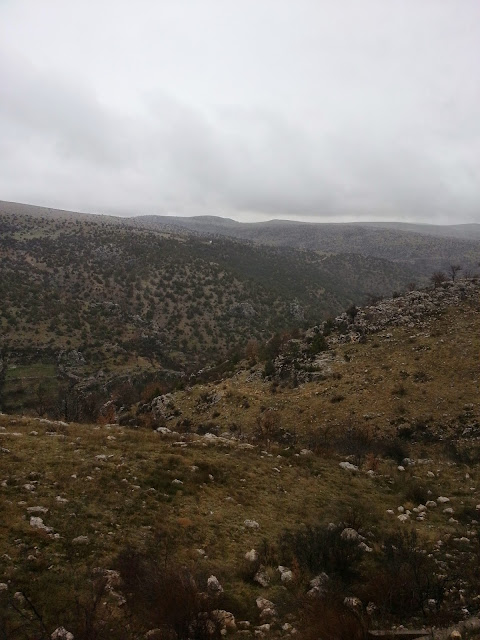 |
| Stones and Shrubs |
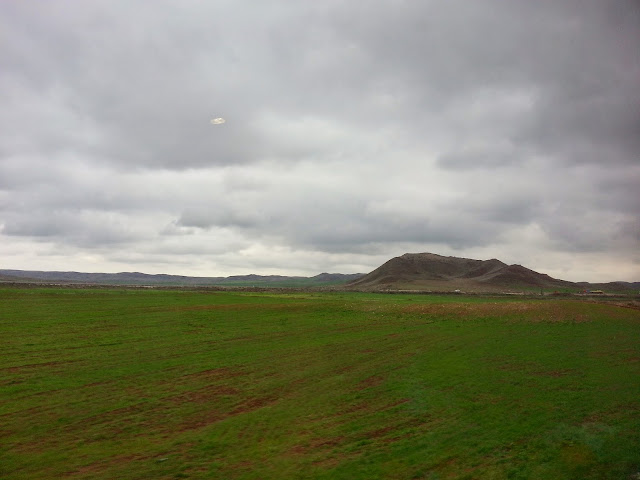 |
| Fields and mountains |
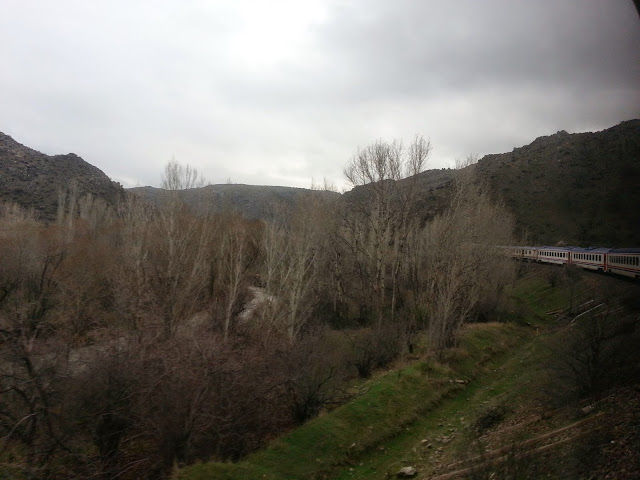 |
| Train through the hills and forests |
 |
| The dilapidated train station |
When we finally arrived in Diyarbakır, we immediately got a sense of the excitement in the city. A crowd of cheering and chanting people met their Kurdish friends coming from Ankara and beyond, and the group marched off loudly into the city. Because Diyarbakır is such an important city to the Kurds, people come from all over the country and the world for the Newroz celebrations.
From the train station we were able to walk easily enough to the old city, which is surrounded by a high stone wall built by the Byzantines. Apparently, it's the second longest wall in the world, after only the Great Wall of China. The upkeep does not seem stellar, but they remain impressive and in good condition. We climbed up to the top, and got views of the old city within the walls and modern sprawl outside. Here we also met two older couples - they were Kurdish people from the region who had been living in France for several decades but who had come back to the city for the celebrations. With my French, we were able to have a nice conversation which I could translate for my friends. One of the interesting things they pointed out was the number of Syrian refugees in the city, and how difficult and sad their conditions are. There are 2 million Syrian refugees in Turkey today (think about that number for a second. Holy moly) and given Diyarbakır's relative proximity to the border, of course there are a lot coming to this city.
 |
| The walls |
 |
| Old moss-covered steps up the walls |
 |
| Byzantine |
From the walls, we ventured further into the downtown, where we could feel more of the city's excitement. We got a lot of attention as a group of seven foreigners, but it was mostly positive and excited.
We wandered into an old 'hanı', which was basically an big inn for traveling Silk Road tradesmen back in the day. Today, it's been converted into shops and restaurants, but it has maintained its unique black-and-white striped stonework, which is particularly distinct to Diyarbakır.
 |
| Fountain in the centre of the hanı |
Soon, we got a call from our hosts. We were Couchsurfing in Diyarbakır, meaning we hadn't yet met the guys now telling us they were coming to pick us up in their pickup trucks. Officially, we were hosted by Emrah, but he was joined by his friend Mehmet who, ultimately, I think was the one who provided the actual space where we stayed (though I was never 100%/ of whose house we were in exactly). Hosting seven people for Couchsurfing is basically unheard of, but Emrah and Mehmet provided a fantastic place to stay - they brought us to a huge, beautiful apartment, and no one even needed to sleep on the floor (which we all expected)! Emrah and Mehmet are engineers working for an oil company with generous housing arrangements for its employees, despite the fact that Emrah lives with his family. I think this is how they had so much free space for us to use.
Immediately upon picking us up (service we never expected!), we were brought to a cafe run by Mehmet's family. We met a number of family members who generously welcomed us. They served us "Kurdish Coffee", a delicious and unique drink. It's hard to describe, but the best way is probably to say that it's like sweet, pistachio-flavoured coffee, thick and strong like Turkish coffee.
 |
| A terrible picture, snapped very quickly of Mehmet's family's 'Kahve Evi' - Coffee House |
After the cafe, we went to the apartment where we decompressed (I think I napped briefly) before going out into the city by night. We had dinner and wine, and also visited the Four Legged Minaret of the Şeyh Mutahhar Mosque. No one seems to be sure why, but the minaret is built on four short pillars. Apparently your wish comes true if you circle it seven times, so of course I did so. According to the çay-seller nearby, it is also good luck to drink çay at his shop, so of course I did not.
 |
| With a large group getting in the way and terrible lighting, I tried nonetheless to get a shot of the whole four-legged minaret. |
 |
| Janina and Theresa standing under under the minaret. |
The next morning was Newroz itself. Wow. I cannot put into words how excited and energetic the atmosphere was. The afternoon before, we had all purchased scarves and flags in the colours of Kurdistan (yellow, green and red), and wore them out. Everyone else was also wearing them, and waving them out of their car windows. People were honking their horns and cheering in the street and calling "Newroz pîroz be!" to each other, meaning 'Happy Newroz'. And this was us still nowhere near the actual festivities themselves.
Emrah and Mehmet drove us to the festival grounds, held, fittingly, at Newroz Park. Traffic was terrible - everyone was going in the same direction. Along the sides of the road, pedestrians streamed along also. When we got to the park, we pushed into the massive crowd that had formed to get through security. On the other side, it was a long walk to the main grounds. As we went, things became more and more congested. The crowds were just massive, and growing more and more as we got closer. Here there were even more flags, costumes, and cheering. Admittedly, we had expected some sort of police presence, even with Newroz being legal now. But I don't think we say a single police officer or vehicle, and all security was provided by individuals associated with the event itself - so there was nothing to dampen the spirits of the event.
 |
| Approaching the heart of the festivities |
Finally we arrived to the heart of the park, a huge flat area packed with people. There was a big stage off at one end, and then just a LOT of people. A bunch of people were dancing in the traditional style, to musicians with drums who floated around among the crowd. Complete strangers grabbed hands (linked pinkies, specifically) and great great dancing circles. Hesitant at first, but bolstered by the infectious excitement and the warm prodding by other members of the crowd (everyone knew we were foreigners, and seemed greatly excited by our presence) we eventually joined in. It was easy enough to follow the steps, and the energy made me smile.
 |
| A line of dancers, arms around each other. |
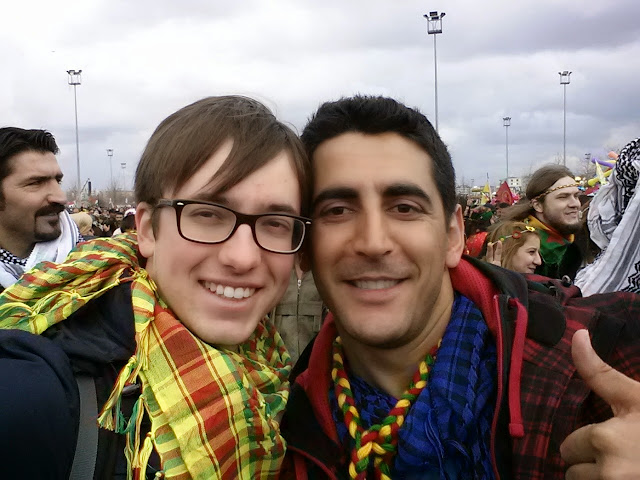 |
| A selfie of Emrah and I. Note the colours of my scarf. |
After a while, an announcement came from the loudspeakers spread around the park - soon, they would be lighting the torch! Newroz, as mentioned, is at the spring equinox, and represents the beginning of a new year and new life. Fire places a huge symbolic role in Newroz, representing the end of the dark season of winter and . A common tradition is for people to leap over a fire to symbolize their purification from the past year's sickness and new, strong beginning (something we didn't get to do - we didn't actually see anyone doing this, and we wonder if it's a tradition that happens more the night before Newroz itself, or whether it happens on a more family-based level rather than in a large crowd. Or perhaps other Newroz celebrants do this, but not so much the Kurds. Just speculating though, I have no idea). The lighting of the huge torch in the middle of the park was thus the focal activity of the entire celebration. We watched as they poured fuel onto the wood, and then lit the torch with a long, burning stick. It didn't take long for the whole thing to go up in flames.
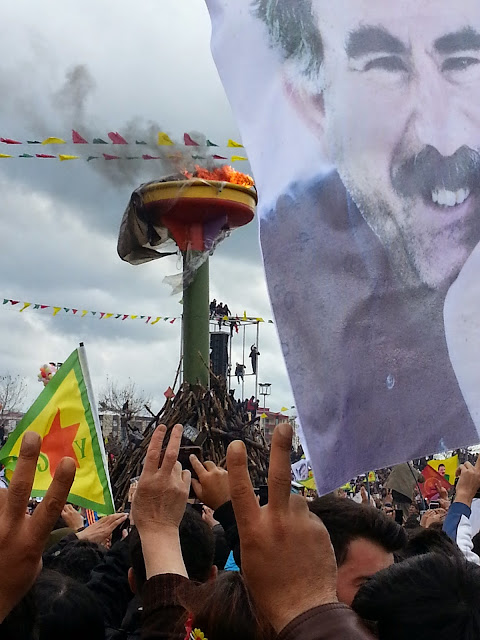 |
| They start to light the torch! Peace signs were a major theme - it's what the Kurdish want, ultimately: the peace and autonomy to preserve their culture and be afforded the same opportunities as others in Turkey. The flag on the right side there features Abdullah Öcalan, the leader of the PKK who is currently imprisoned. Many people called for his freedom throughout the day, and he later gave a speech to the audience, delivered by an MP for the pro-Kurdish political party. He called for a complete ceasefire, with an end to the PKK insurgency, and for a Kurdish Congress to meet in the next few months, in return for concessions from the government. |
 |
| The torch fully lit! Kurdish flags waving excitedly as everyone cheers and whistles. |
 |
| The smoke billows off of the torch! I don't think I've ever been in a crowd that has felt more positive, more energizing, and more revolutionary! |
After the torch was lit, we milled about some more, dancing and laughing and taking pictures with people who wanted a selfie with tall, blonde Germans. Speeches (in Turkish and Kurdish, so I didn't get much out of them) were read from the stage, and some bands performed. We ate ciğer, that is grilled chicken liver, a specialty of Diyarbakır. As it got later into the afternoon, it started to rain and we looked for shelter. A whole bunch of people seemed to be moving into some apartment buildings that were under construction, and we joined. There were no walls to the exterior, just the basic frame of the building. But it was enough to keep us out of the rain and wind.
 |
| Looking back from the apartment buildings where we took shelter to the crowds of Newroz. |
While sheltered in these apartments, a man approached my friend Nicola. They exchanged a few words, since Nicola's Turkish is decent for a foreign. And then before we knew it, this man was insisting we come visit his home. We were a bit enough group that we felt comfortable doing so, and we thought "hey, we're only in Diyarbakır once - why not?" What a great privilege it turned out to be. The man's whole extended family was at home, as Newroz is a holiday best shared with family. Everyone was excited and happy to have us, and there were a lot of kids we could speak to a little bit and play with. They served us a dinner (actually, we had to ask them, as politely as possible, only to serve us one course. They were so generous and wanted us to eat a lot, but we didn't want them to spend all their time cooking for us not for themselves! Not the mention the financial burden of cooking for 9 or so more people than you had planned!). This was the legendary Turkish generosity I had heard so much about (though I guess, technically, it was Kurdish generosity in this case). The food was stellar. Lukas and Nicola had enough Turkish communicate a bit with the family patriarch and some of the other men. Theresa and Janina were welcomed to join the women in the kitchen, where they were offered cigarettes - classic for conservative regions of the country, where it isn't considered appropriate for women to smoke in the same room as men). And of course children don't care too much about language, and still wanted to play games and have us take pictures of them. The interactions were inspiring and enlightening and fun.
 |
| Theresa takes a picture of several of the women and their kids. Lukas is in the blue hoodie and Ana is beside him with the coloured headband, in the centre of the picture. |
 |
| The crowd saying goodbye to us as we, sadly, head out. The blurry guy in the front here is Nicola. |
After eating, we headed back to the old city itself to see some more sights and have enjoy the evening. We passed a statue of the famous Atatürk in a square. It was interesting because when we saw him here it struck me suddenly how little we had seen of him elsewhere in the city. In Ankara and most other parts of the country, Atatürk is everywhere - his picture hangs in bars and restaurants and offices, and is plastered on flags and billboards and souvenirs. And yet here in Diyarbakır, this was so much less the case.
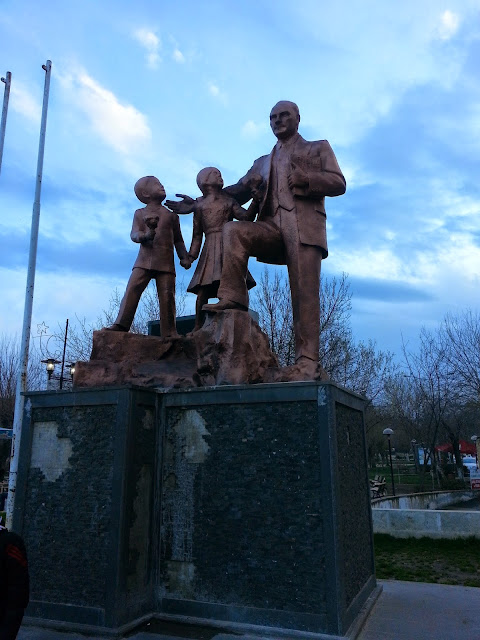 |
| Statue of Atatürk and children |
 |
| A tower of the old city wall, on the other end of the city from where we were the day before. |
We next checked out the Ulu Mosque, which was a beautiful building with a grand courtyard. It was built in the 11th century. We were there at dusk, and the light of the sunset made things much prettier than the pictures can express.
 |
| Courtyard of the Ulu Camii (mosque). |
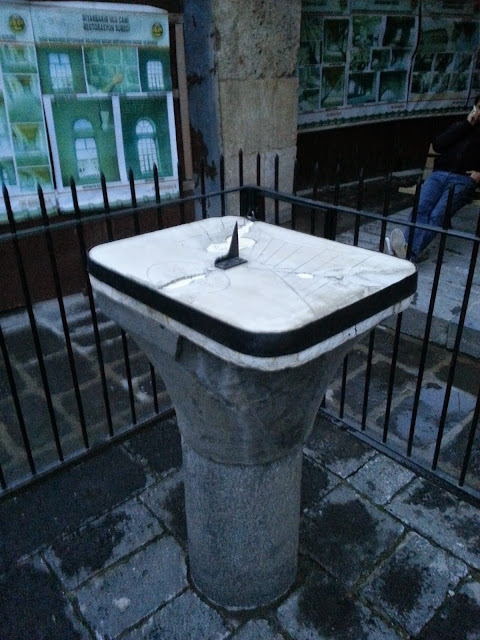 |
| A sundial in the courtyard of the Ulu Camii. |
 |
| The dark stone of the Ulu Mosque. |
 |
| Another part of the Ulu Mosque courtyard. |
.jpg) |
| The beautiful inside of the Ulu Mosque |
 |
| More interior of the Ulu Mosque, with huge chandeliers. |
From the mosque, we headed back to the central city hanı, where we drank Turkish coffee in one of the original rooms. Several friends of our hosts joined us here, and brought a drum. They sang traditional songs for us, and at one point a random women from another part of the restaurant stuck her head in and asked if she could join in the singing. She had a stellar voiced and wowed us all with traditional singing. Later in the night we drank some wine from the region - I think it remains the best wine I've had in Turkey so far.
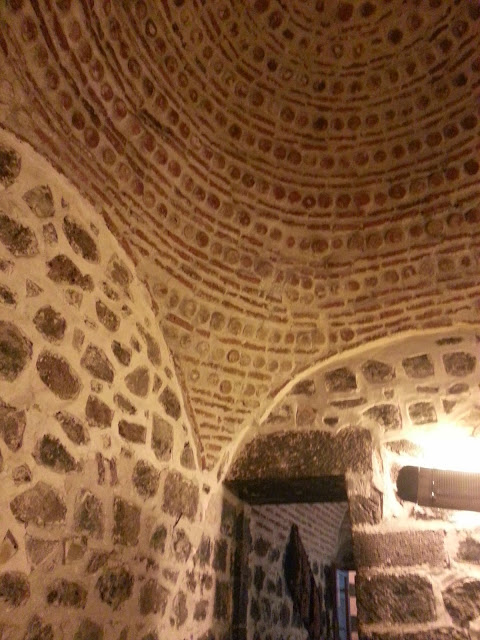 |
| It's not a good picture, I know, but I wanted to give a sense of our room in the hanı, and the original stonework which provided great atmosphere. |
The next morning, we sadly had to head home. We cooked a big breakfast for our hosts as a thank you, trying to combine Turkish classics with our international touch. Emrah, especially, and all of his friends we met in the city made our experience truly unique and incredible (this is why Couchsurfing is just great) and it was sad to say goodbye. But we headed back, nonetheless to the train station, where people were still singing and dancing even on the platform.
Another 20 hours on the train, where we picnicked and watched movies and chatted, as we had now all become so much closer. And the scenery - new this time, since we had slept through this part of the country before - continued to be stunning. Needless to say, going back to school and reality as soon as the train got in was tough.
 |
| There is a saying in Turkey: "The Kurds have no friends but the mountains". Pretty beautiful friends, if you ask me. |
That's all for now - but I'm making a promise about some other blog posts. I'm finishing up the last week of my classes right now, and then I have two weeks of exams and final papers. Then on the last day of exams, my Canadian friend Jess is joining me in Ankara for some adventures. I'm so excited, but I'm annoyed at how behind I am with this blog - I know it will not be much easier once I'm on the road. So I am committing to catch up before Jess arrives (and what better way to procrastinate studying than by blogging??). That is to say, before 5:45pm, Ankara time, on June 6th, 2015 - the time when Jess' flight lands - there will be 3 more blog posts up, about trips to Esikşehir (this one will probably be mostly photos, less text, for sure), Greece, and the Turquoise Coast. This is a guarantee, or your money back. So stay tuned.












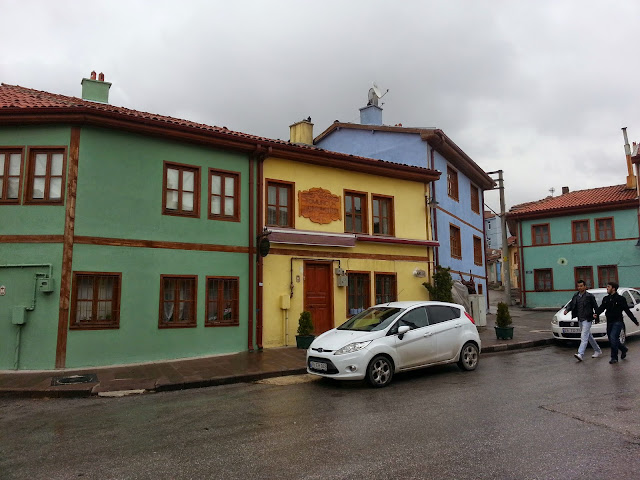




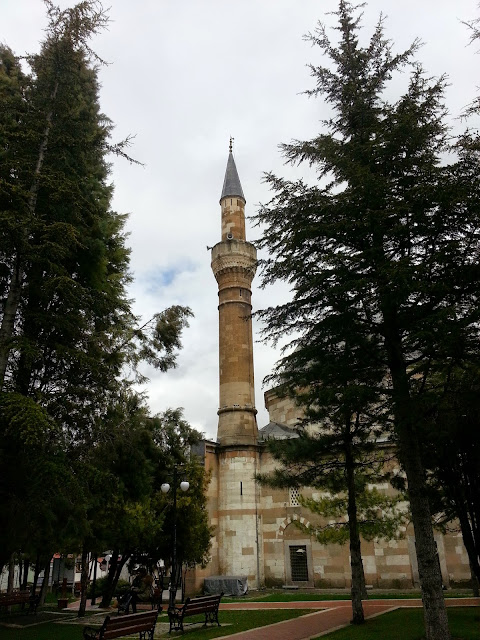































.jpg)


